- JAPANESE
- LANGUAGE
X
 THAT IS GOOD
THAT IS GOOD
January 26th, we went to Miyagi Zao to shoot Kuniyuki in the snow monsters.In the severe winter season in Zao, the sunshine rate is only 20~30%, but we were able to take pictures in a magnificent *juhyo forest, which is rare in recent years, and took advantage of a moment of clear weather.
*Juhyo : frost-covered trees, rime on trees or the snow monsters.
The preparations for this shoot began with location scouting in Yamagata Zao in early January.
In Yamagata, there is a fellow company called Connectech Co.,Ltd,(hereinafter referred to as Connectech) which has been responsible for the stage area for the Ryugan-sai, which has been held 12 times until 2017 and is considered to be one of the largest free festivals in Tohoku.
At the end of last year, we had an idea to take a shoot with rime on trees, and they said, “That’s a good idea,” but they kept saying, “It’s too hard, it’s too cold, it’s rarely sunny. If it’s going to be that tough, we need to see the area, so we did a location scout beforehand.
On January 5th, we took the Shinkansen to Zao. From Yamagata Station, we were picked up by a car driven by Yasu from Connectech and headed for Yamagata Zao Onsen Ski Resort.
First, we stopped by “Zaoonsen Otochaya”(hereinafter referred to as Otochaya), which is run by Connectech. Otochaya is a very stylish café that usually hosts live music events on a regular basis.
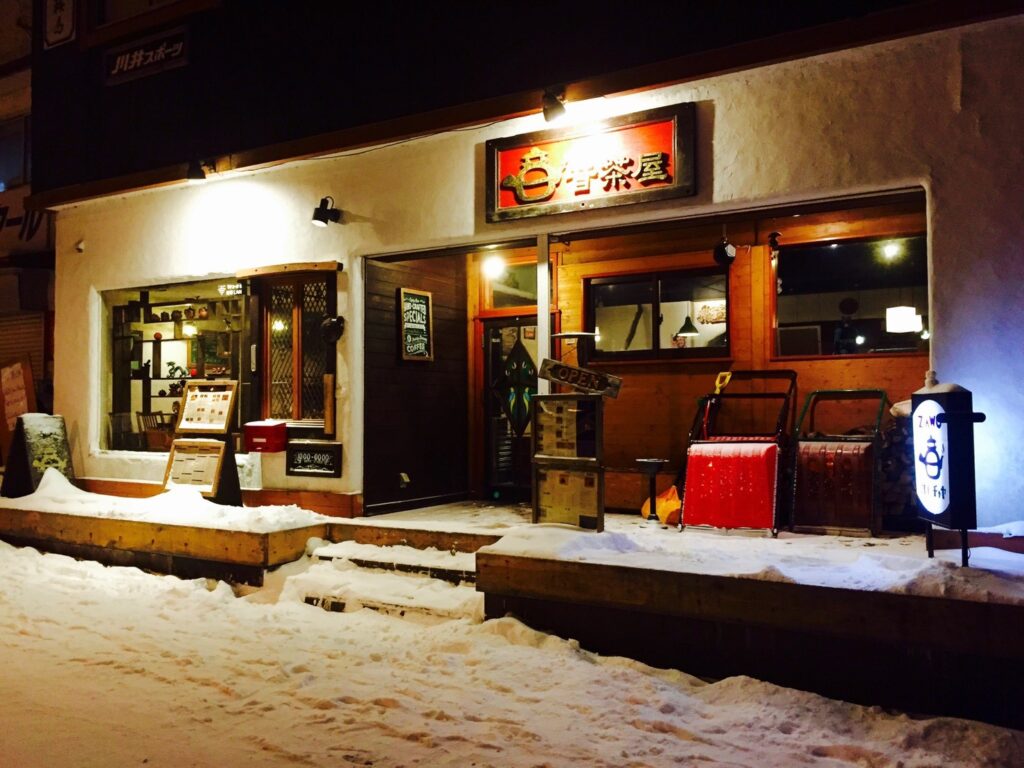
We discussed whether or not the equipment would work in the cold, and how to keep the equipment and performers warm. Shinya from Waon, who introduced us to Connectech, said, “Let’s see if we can get the PC to work on site tomorrow,” and we struggled over whether to use his PC or mine. Is there any way to add a windbreak to the booth? What kind of heaters could we use? We discussed these and other issues until almost midnight.
The next day, however, it was sunny and cloudless.
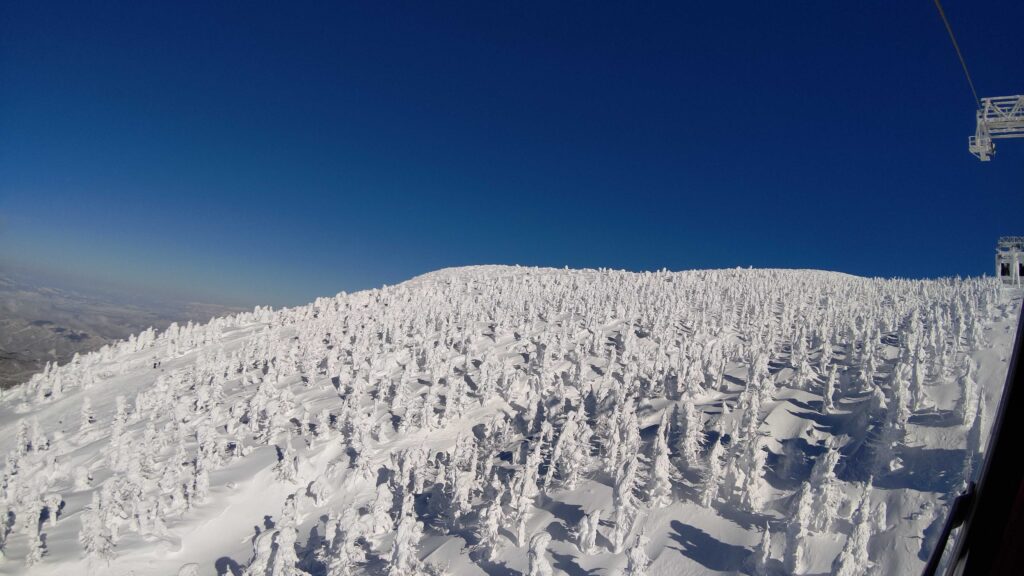
As we took the Zao ropeway to the top of the mountain, the scenery gradually changed, and from our feet all the way to the top of the mountain, the most beautiful juhyo forest I’ve ever seen spread out. It was an out-of-this-world sight, with the glistening ice trees growing thickly against the blue sky. Looking back from the mountaintop station, I could see the mountains of the Asahi mountain range shining in the distance beyond the Yamagata Basin.
To be honest, although I knew about the juhyo, this was the first time I had seen it with my own eyes. If I hadn’t taken this video, I probably wouldn’t have had the chance to see it until much later. However, the beauty of the juhyo forest I saw for the first time was overwhelming, and my desire to shoot in the juhyo became stronger again.
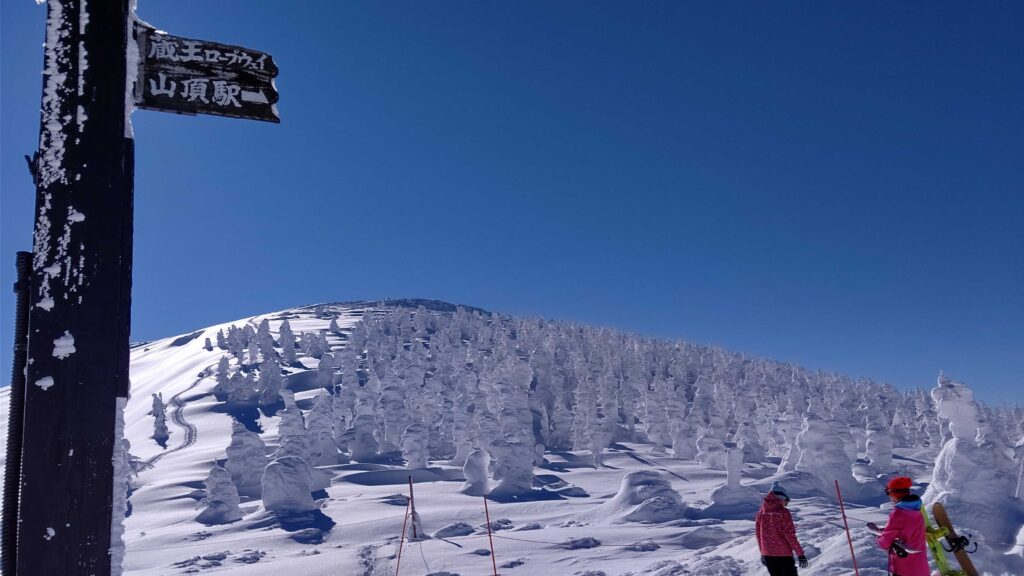
However, Shinya stayed until the next day, and that afternoon he experienced a snowstorm that made it impossible for him to even see in front of him. Would we be able to shoot safely?
There are two types of juhyo, one is “Rime” which is a meteorological term found all over Japan and overseas, and the other is “Snow Monster” and “Ice Monster” which are nicknames found in places like Zao and Hakkouda. In other words, Zao’s juhyo, also known as Snow Monster, is a popular nickname for “a huge mass of Aomori fir covered with ice and snow from snowfall. In Zao, the term “juhyo” is used only for ice that has formed on Aomori todomatsu (Abies mariesii) and has grown to a huge size, and not for ice that has formed on other trees. The scarcity of these trees makes them a tourist resource.
By the way, have you ever seen the image of bottled water turning into sherbet the moment it is poured?
This phenomenon occurs because the water is “supercooled. Supercooling is a state in which water does not freeze even when it is below 0 degrees Celsius, and when it receives a sudden stimulus, it changes into ice at that moment.
Water droplets of fog (fog grains) generated during the cold winter months may drift in the air in such a supercooled state. It is also said that the smaller those fog grains are, the more they maintain their supercooled state even in lower temperatures. The smaller the grains are, the more they stay supercooled even in cooler temperatures. In the special conditions of high altitude, they hit trees such as Aomori todomatsu (Abies mariesii) from one direction and crystallize at that moment… Then, the crystals grow larger upwind and become tree ice.
In particular, the topography of Zao is suitable for the formation of juhyo, as the winter winds coming from Siberia moisten the waters of the Sea of Japan and rise in the Asahi mountain range, causing snow to fall. Afterwards, the clouds containing a moderate amount of moisture due to supercooling rise again in the Zao mountain range through the Yamagata basin. Jizoyama in the Zao mountain range, they collide with the abies mariesii from one direction and form magnificent juhyo, which is rare in the world.
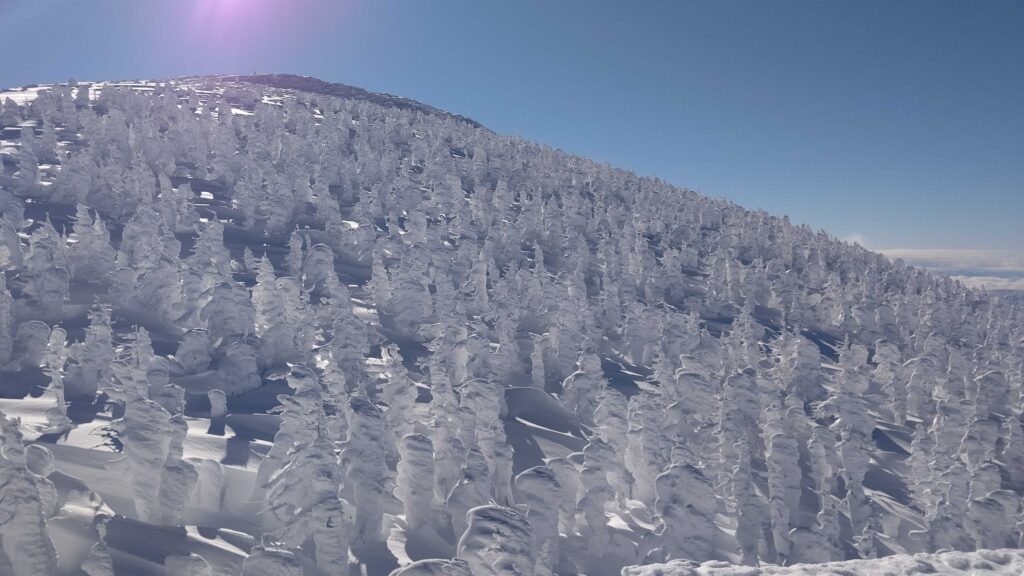
After that, considering various circumstances, we decided to change the schedule of shooting in Yamagata Zao to Miyagi Zao. In Miyagi Zao, we were able to ride a snowmobile to the juhyo area near the top of the mountain, thanks to the cooperation of Sumikawa Snow Park, also arranged by Connectech. However, it is still necessary to take measures against the cold during the shooting. While watching the weather, we decided on January 26 as the shooting date, and decided to enter Zao, Miyagi Prefecture on the night of January 24. On the 25th, we started location scouting in the morning, and to our surprise, it was a beautiful sunny day.
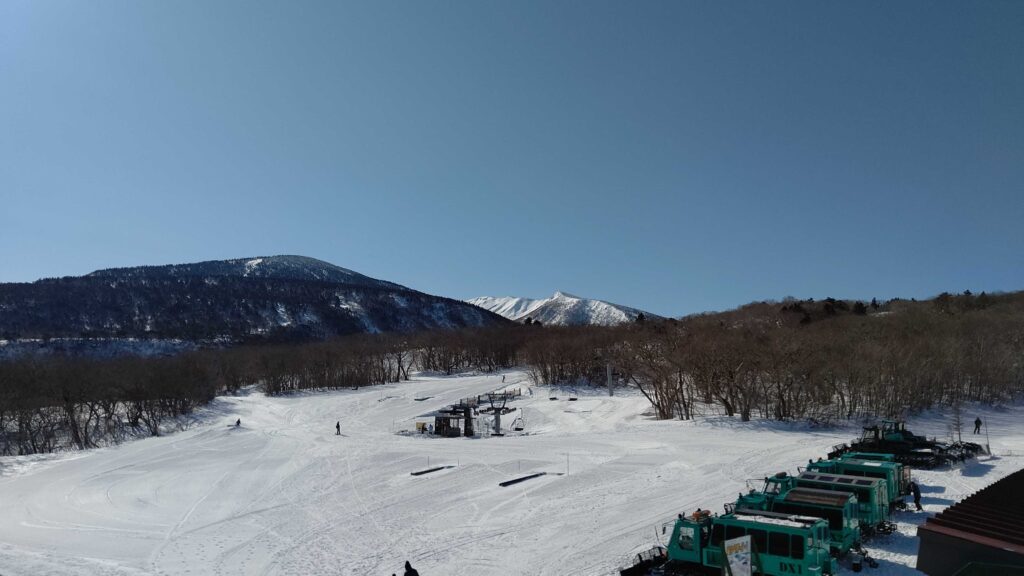
We rode on the snow tractor for about 45 minutes to the top of the mountain and decided where we wanted to take pictures. We then climbed to the top of Kattamine, where we were able to see the Kattamine Shrine and its torii, which is a huge lump of snow formed by supercooled water icing, as well as the crater called ” Okama” on the other side of the peak. However, it was very windy and exposed near the top, so we couldn’t stay there very long. We prayed for the success of the next day’s shooting at the Kattamine Shrine and returned to the location.
Mr.KUNIYUKI arrived in the afternoon by snow tractor, and we were able to have a look at the site and get more inspiration for the shoot.
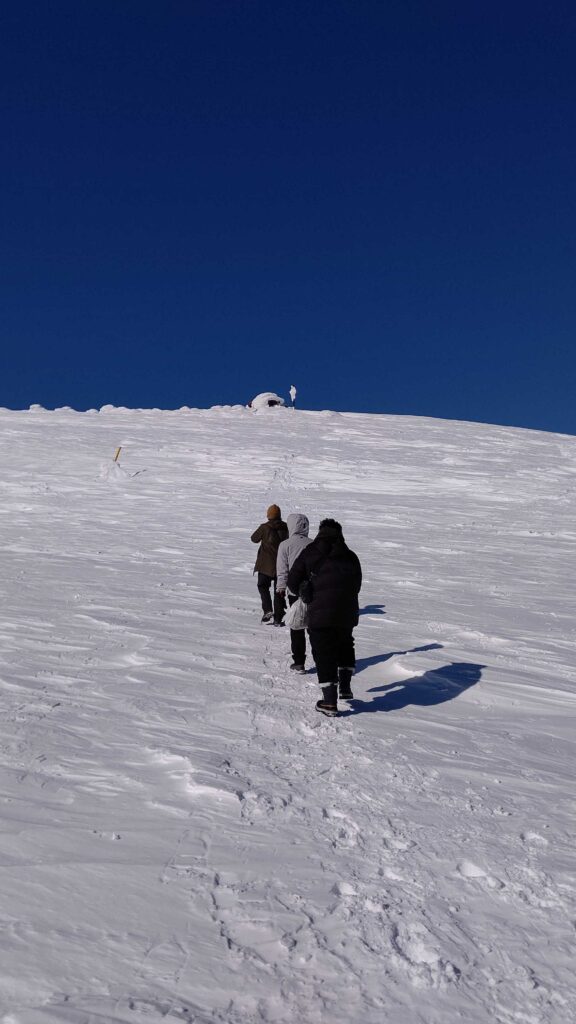
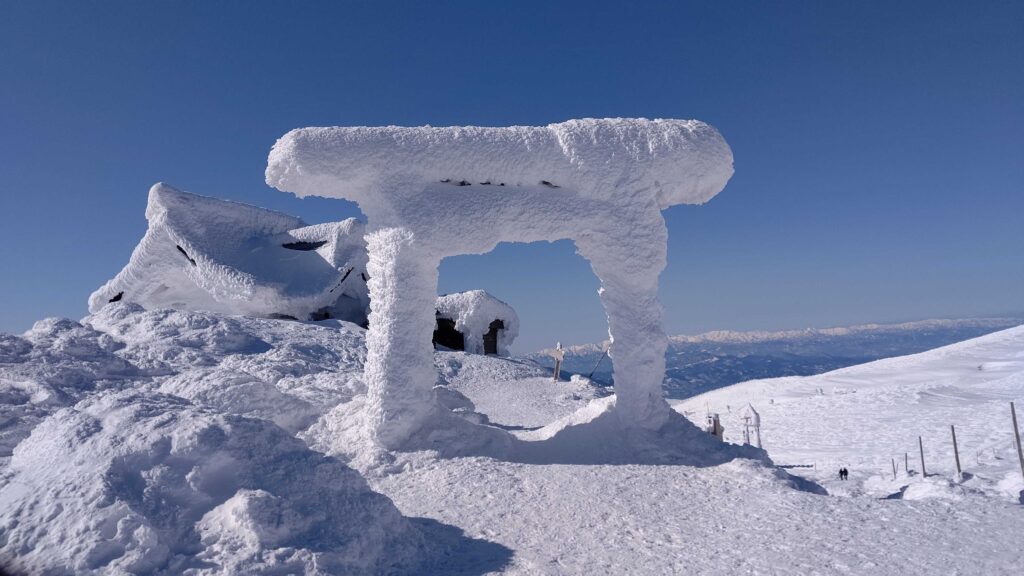
If only the weather would stay like this, but it was forecast to get worse the next day. At any rate, we took a hot spring bath to rejuvenate ourselves for the actual event.
The Connectech members who had accompanied us on the location scouting trip headed back to Yamagata. It took them more than two hours to get there and back, and they would join us again the next morning as staff with their equipment.
We gathered early in the morning to go to Sumikawa Snow Park…We had a snow tractor ready to leave the slopes at 8:00am, earlier than usual, and we were led by a snowmobile (snowmobiles lead the way as it is difficult to pass people skiing and snowboarding on the slopes and there are narrow areas where it is difficult to pass each other) with a full load of equipment to the juhyo area.
It was still a beautiful day on the way and the crystals on the surface of the snowfield were glistening in the sun.
The weather was not as clear as yesterday, but on the contrary, the scenery was fantastic and the foothills of the mountains on the Yamagata Basin side were enveloped in a sea of clouds. I want to complete our shooting before those clouds arrive.
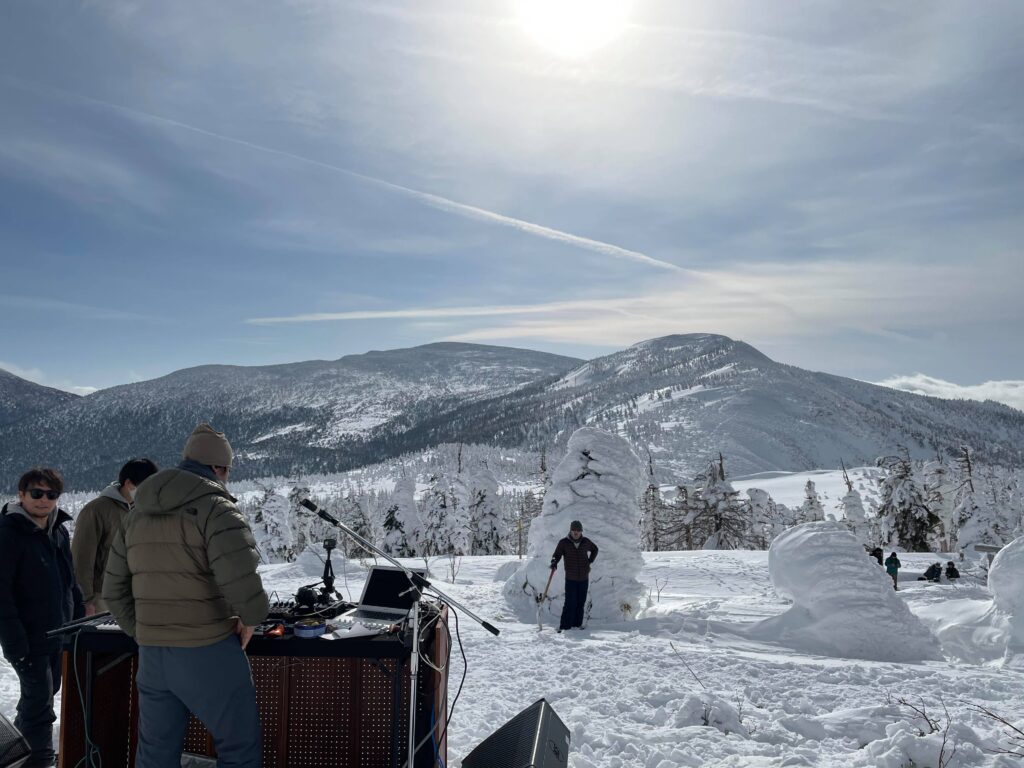
We hurriedly start preparing the equipment. Yuichiro, the manager of Otochaya, also joined us as a staff member of Connectech. We set up the sound equipment and booth and started filming. It was a little cloudy and sometimes the clouds from the sea of clouds would come up, but we were able to shoot without any problems. We moved the snow truck to a remote location and waited while we filmed KUNIYUKI’s performance echoing across the snowfield and ice forest.
There was no wind, so we were able to perform without heating equipment, but I think it was still too cold to play the instruments with bare hands. However, the beautiful scenery of the ice forest spread out in front of us made us feel excited, and KUNIYUKI seemed to enjoy playing along with the music. We were able to record a wonderful performance that matched the fantastic scenery.
We were blessed with good weather and finished shooting. All right, let’s get cleaned up, so I unpacked the equipment and carried it to the snowmobile. About five minutes into the cleanup, I looked back and saw that the booth where KUNIYUKI had been performing and the scenery beyond it were quickly covered by clouds and the area had turned completely white.
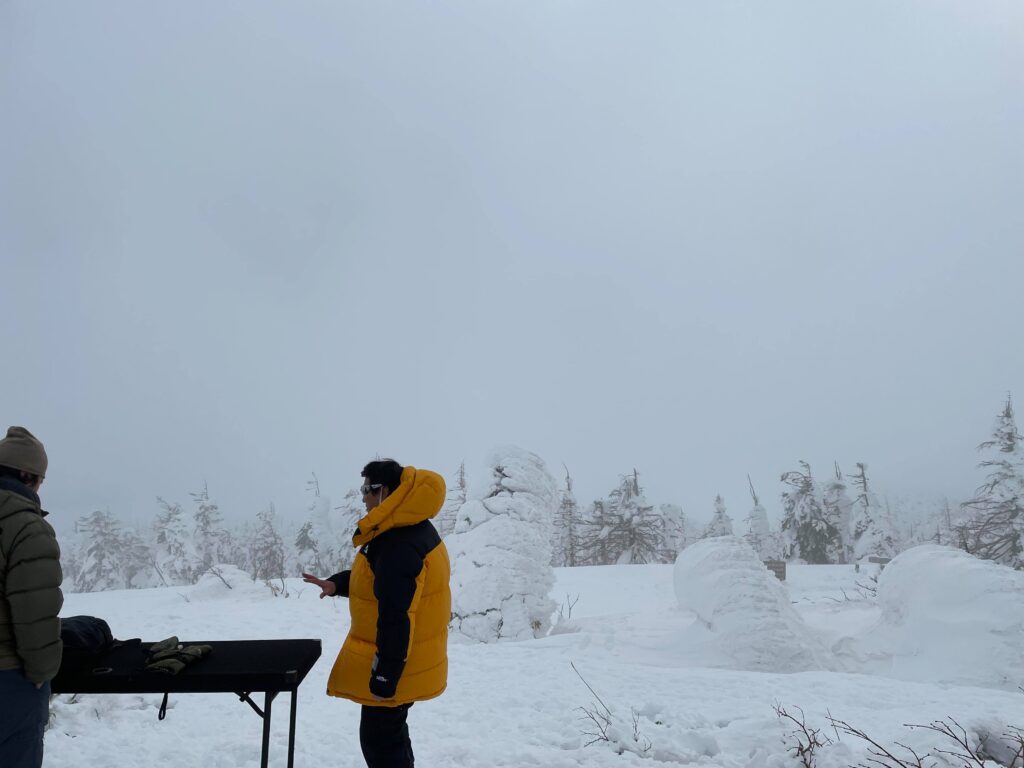
In the past, THAT IS GOOD has recorded wonderful works through numerous encounters and miraculous coincidences. Last year’s recording on Kudaka Island in Okinawa (to be released soon) was shot in a moment of divine sunshine, and this time we were blessed with miraculous weather and were able to record it safely.
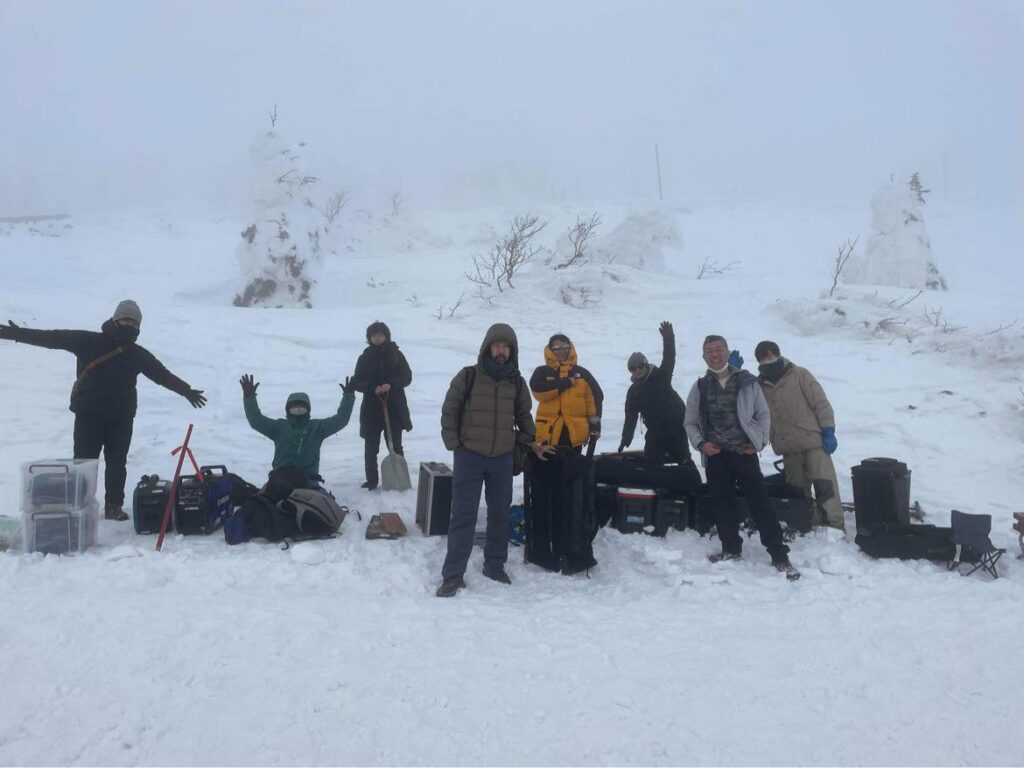
Please enjoy the beautiful scenery covered with juhyo, which is said to be unusually magnificent in recent years, and the wonderful performance by KUNIYUKI!
From Tokyo to the north, take the Yamagata Shinkansen (approx. 2.5 hours) and take a bus from Yamagata Station (approx. 40 mins).
1 hour and 40 minutes by Tohoku Shinkansen, 90 minutes by highway bus from Sendai Station.
By air: 60mins from Yamagata Airport on the “Delicious Yamagata Sightseeing Liner” (shared cab).
From Sendai Airport: 110mins on the Zao-go (ski bus) *only available in winter due to ski bus service.
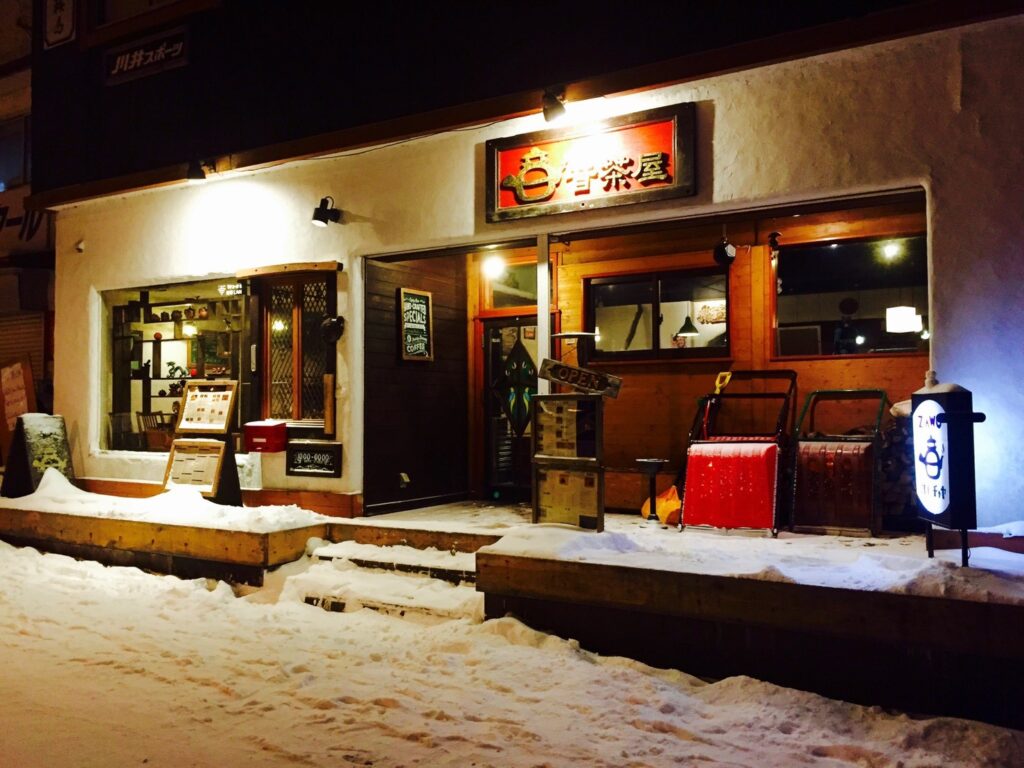
Adress : 935-24, Zao Onsen, Yamagata City, Yamagata Prefecture
If you drive along the Zao Highway from the city to Zao Onsen, you will come to a T-junction at the entrance of the hot spring resort.
SNS
HP http://otochaya.jp/
Twitter @otochaya
Facebook https://www.facebook.com/otochaya/
Instagram @otochaya
Yamagata Zao Onsen is a strongly acidic sulfur spring with an abundance of hot water. Since it is located at the foot of a ski resort, there are various accommodation facilities from resort hotels to hot spring inns.
There are also three public bathhouses, Kamiyu, Shimoyu and Kawarayu. Kamiyu, which was rebuilt in 2011, has an old-fashioned atmosphere and is the oldest of the three bathhouses, having been used as a public bathhouse since the Edo period. The streets of the hot spring town are also very emotional with the steam rising from everywhere.
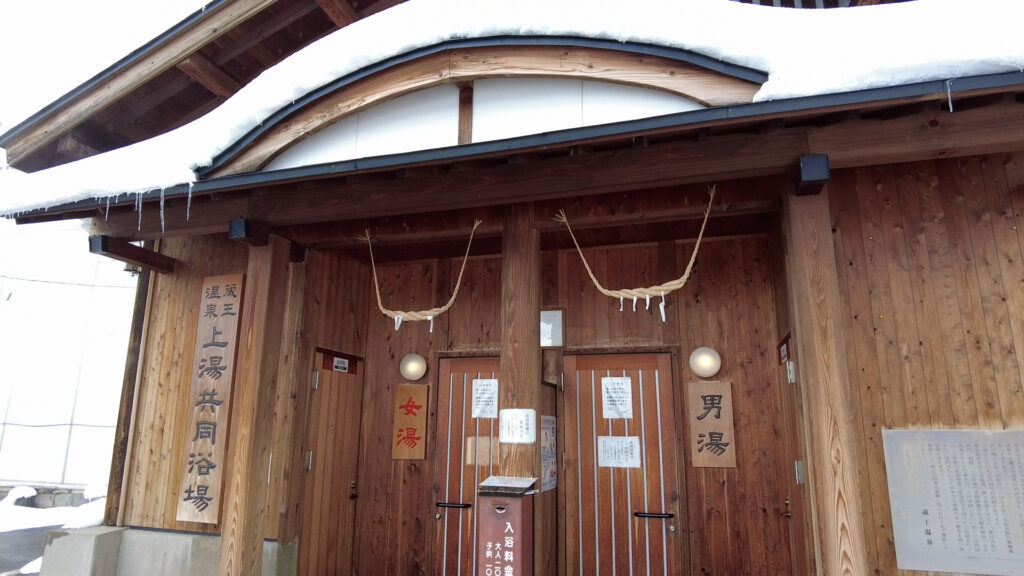
The ropeway station is located just above the hot spring resort, and you can transfer at Juhyo Kogen station to go up to the top of the mountain where you can see the source of the ice. It is a very spacious ski resort, and is very popular because you can ski very close to the juhyo at the top. There is a restaurant and a terrace at the top, and many tourists, not just skiers, visit the resort, which is also used for trekking during the non-winter season.
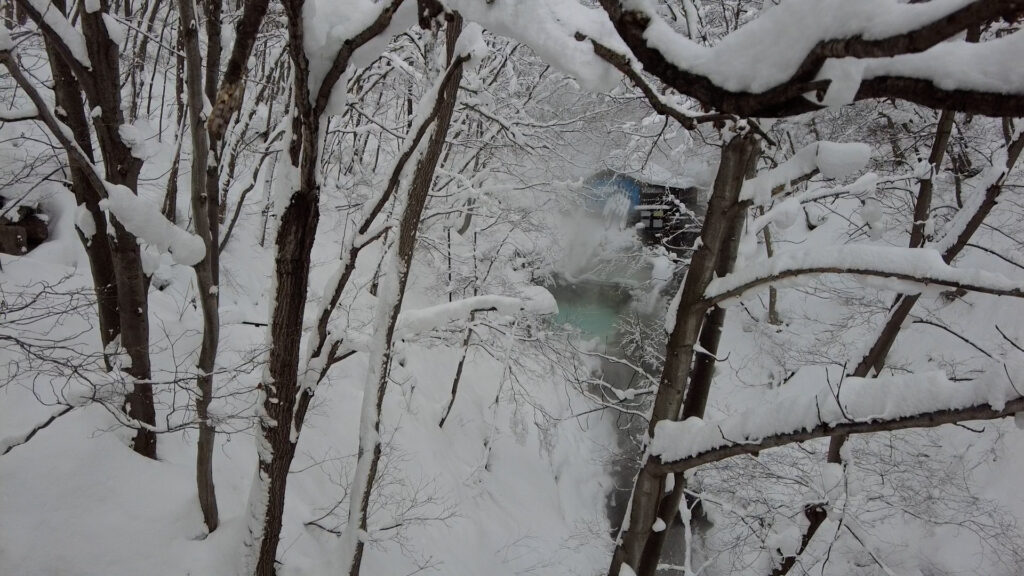
110 minutes by Tohoku Shinkansen from Tokyo, 75 minutes by highway bus from Sendai Station.
Or, 150 minutes from Tokyo by cab from Shiraishi-Zao Station.
From Sendai Airport, take the “Miyagi Zao Onsen Bus” for about 1 hour.
(From Sendai Airport to Togatta Onsen. From there it is a 30-40 minute drive to Sumikawa Snow Park.)
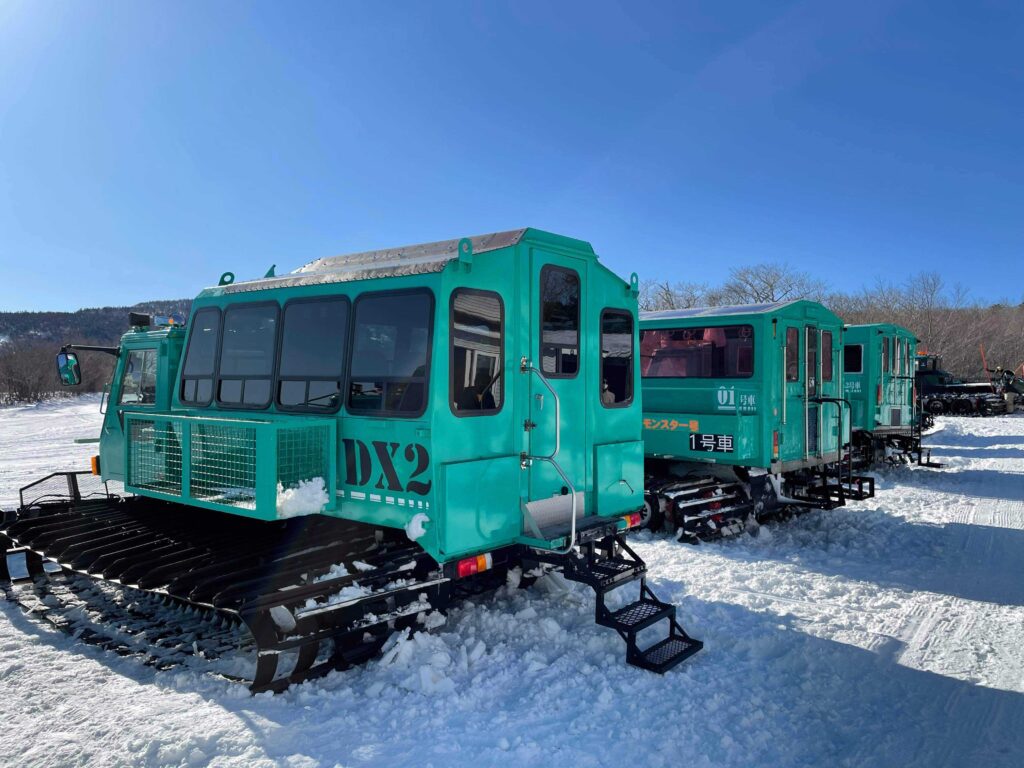
If you drive for a while, you will find two slopes, Miyagi Zao Eboshi Resort and Miyagi Zao Ski Resort Sumikawa Snow Park. Sumikawa Snow Park is 30-40 minutes away by car, and there is a regular bus service from Togatta Onsen to the slopes. The juhyo tour on the Wild Monster, a snow truck with heaters, is a sight to behold. 45 minutes one way on the snow truck will take you right into the middle of the juhyo field. If you take this snowmobile to just below the top of Karitamine, you can walk to the top in about 30 to 40 minutes, and if you ask for a guide, you can ski or snowboard from there back to the slopes.
Miyazaki Zao Togatta Onsen is a sulfate/chlorides spring that contains a lot of sodium and calcium, and is a neutral hot spring that does not irritate the skin. There are two public bathhouses here as well, Kami-no-yu and Kotobuki-no-yu. Kami-no-yu was newly rebuilt in 2006 and is a bit larger than the public bathhouse in Yamagata Zao Onsen.
文:THAT IS GOOD 編集部 中村
Text:THAT IS GOOD editorial department Nakamura